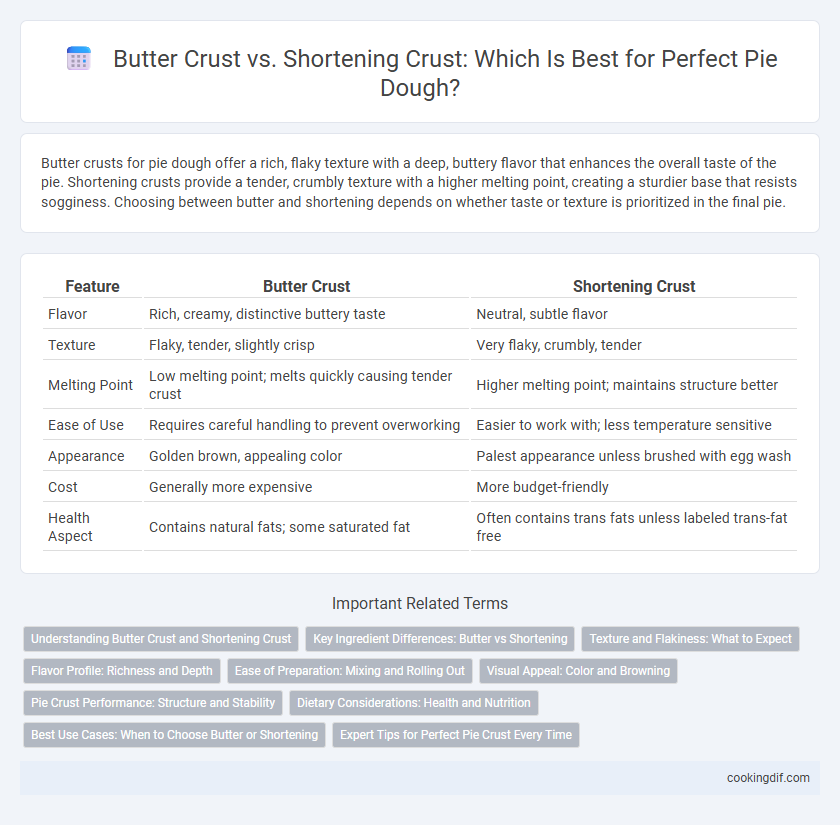Butter crusts for pie dough offer a rich, flaky texture with a deep, buttery flavor that enhances the overall taste of the pie. Shortening crusts provide a tender, crumbly texture with a higher melting point, creating a sturdier base that resists sogginess. Choosing between butter and shortening depends on whether taste or texture is prioritized in the final pie.
Table of Comparison
| Feature | Butter Crust | Shortening Crust |
|---|---|---|
| Flavor | Rich, creamy, distinctive buttery taste | Neutral, subtle flavor |
| Texture | Flaky, tender, slightly crisp | Very flaky, crumbly, tender |
| Melting Point | Low melting point; melts quickly causing tender crust | Higher melting point; maintains structure better |
| Ease of Use | Requires careful handling to prevent overworking | Easier to work with; less temperature sensitive |
| Appearance | Golden brown, appealing color | Palest appearance unless brushed with egg wash |
| Cost | Generally more expensive | More budget-friendly |
| Health Aspect | Contains natural fats; some saturated fat | Often contains trans fats unless labeled trans-fat free |
Understanding Butter Crust and Shortening Crust
Butter crust delivers rich flavor and a tender, flaky texture due to its high water content, which creates steam during baking. Shortening crust offers superior flakiness and a consistently tender crumb because its 100% fat content prevents gluten formation more effectively. Both fats impact dough handling and final texture, with butter prized for taste and shortening valued for ease and structure.
Key Ingredient Differences: Butter vs Shortening
Butter crust pie dough offers rich flavor and a tender texture due to its high water content and natural milk solids, which create steam during baking for flakiness. Shortening crust pie dough provides a more stable, crumbly texture with a higher melting point that prevents shrinking and produces a consistently soft, less greasy crust. The key ingredient difference lies in butter's water content and flavor compounds versus shortening's pure fat composition, impacting moisture, flakiness, and taste in the final pie crust.
Texture and Flakiness: What to Expect
Butter crusts yield a rich, tender texture with a naturally flaky structure due to the water content in butter that creates steam during baking. Shortening crusts produce a more uniform, crumbly texture and offer superior flakiness because shortening has a higher fat content and no water, reducing gluten formation. Choosing butter results in enhanced flavor and moist layers, while shortening ensures consistent, flaky layers with less shrinkage.
Flavor Profile: Richness and Depth
Butter crust offers a richer, more flavorful pie dough with a creamy texture and deep, buttery notes that enhance the overall taste experience. Shortening crust provides a neutral flavor and tender, flaky texture but lacks the depth and richness imparted by butter. The choice between butter and shortening significantly affects the pie's flavor complexity and mouthfeel, making butter ideal for a more indulgent dessert.
Ease of Preparation: Mixing and Rolling Out
Butter crust offers a smoother mixing experience due to its natural moisture content, making dough slightly softer and easier to blend. Shortening crust tends to be firmer and less sticky, which simplifies rolling out without excessive flour but may require more effort during mixing. Both options provide workable dough textures, yet butter's pliability often results in a more manageable preparation process for novice bakers.
Visual Appeal: Color and Browning
Butter crusts produce a golden-brown, visually appealing crust due to the milk solids caramelizing during baking, enhancing both color and flavor. Shortening crusts tend to bake into a paler, more uniform color, lacking the rich browning that butter provides. The choice between butter and shortening directly affects the pie's aesthetic and perceived freshness through crust coloration.
Pie Crust Performance: Structure and Stability
Butter crust offers superior flavor and creates a flakier, more tender pie crust due to its water content, which produces steam during baking, enhancing structure and stability. Shortening crust provides higher stability and a sturdier texture because of its 100% fat content, which results in less shrinkage and a more consistent, durable pie shell. For optimal pie crust performance, butter is preferred for its taste and flakiness, while shortening excels in maintaining shape and structural integrity.
Dietary Considerations: Health and Nutrition
Butter crust offers higher saturated fat and calories but provides natural flavor and contains less processed ingredients compared to shortening crust. Shortening crust typically has zero trans fats when using non-hydrogenated versions and creates a flakier texture with lower saturated fat content. Choosing between butter and shortening crust depends on dietary goals related to heart health, calorie intake, and preference for natural versus processed fats.
Best Use Cases: When to Choose Butter or Shortening
Butter crust provides rich flavor and flaky texture ideal for fruit pies and tarts, where taste is a priority. Shortening crust excels in producing tender, crumbly results, making it perfect for savory pies like quiches or recipes requiring minimal shrinkage. Choosing butter enhances aroma and crispness, while shortening delivers superior dough workability and consistent rise.
Expert Tips for Perfect Pie Crust Every Time
Butter crust delivers rich flavor and flaky texture due to its higher water content and melting properties, while shortening crust offers superior tenderness and less shrinkage thanks to its 100% fat composition. Expert tips emphasize using chilled ingredients and minimal handling to prevent gluten development, ensuring a crumbly, delicate crust. Combining butter and shortening in a 50/50 ratio can balance flavor and texture, providing a perfect pie crust every time.
Butter crust vs Shortening crust for pie dough Infographic

 cookingdif.com
cookingdif.com